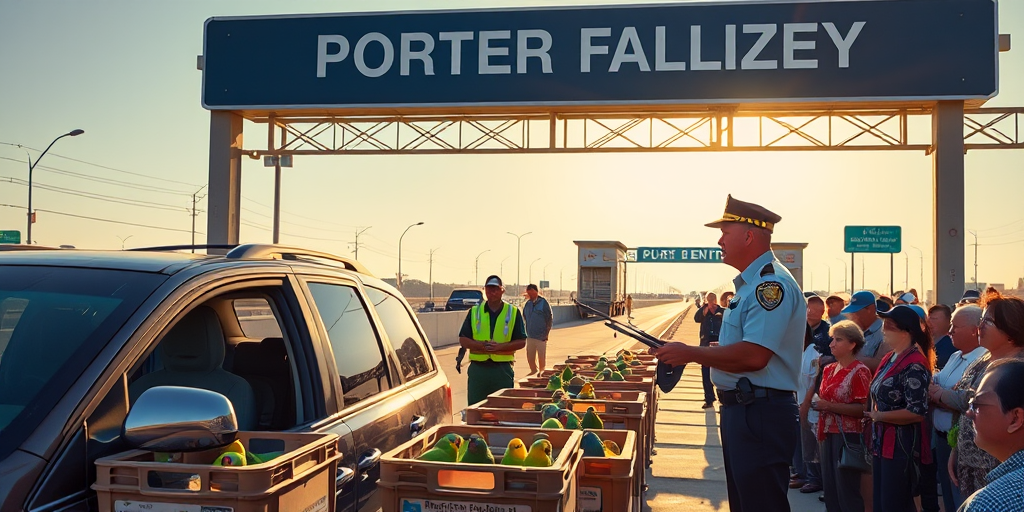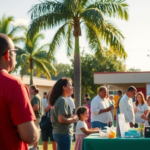Hidalgo CBP Officers Intercept 20 Undeclared Parrots; Driver Arrested
A significant wildlife trafficking attempt was thwarted at the Hidalgo Port of Entry on July 7, when U.S. Customs and Border Protection (CBP) officers and agriculture specialists intercepted 20 undeclared parrots concealed in a vehicle. This incident highlights the ongoing challenge of wildlife trafficking and the role of CBP in protecting endangered species.
Unveiling the Smuggling Attempt
During a routine inspection amid heavy holiday weekend traffic, a 22-year-old female U.S. citizen attempted to cross into the United States with parrots hidden in a bag inside her Chevy Traverse. CBP officers, demonstrating vigilance typical of their operations, referred the vehicle for a secondary inspection which led to the discovery of the birds.
Port Director Carlos Rodriguez expressed his appreciation for the officers’ commitment: “Our frontline CBP officers remain resolute in their mission to prevent the exploitation of protected animals and to stop the spread of diseases. This interception highlights our effectiveness despite increased traffic.”
Importance of Parrot Protection
Parrots, protected under the Convention on International Trade in Endangered Species of Wild Fauna and Flora (CITES), face numerous threats due to their popularity in illegal wildlife trade. Their importation is regulated by the Centers for Disease Control and Prevention (CDC), and violations can result in severe penalties, including fines and imprisonment.
The investigation into this incident has been taken up by Homeland Security Investigations in collaboration with the U.S. Fish and Wildlife Service. Their joint efforts underscore the serious implications associated with wildlife trafficking, aiming to bring those responsible to justice.
Local Impact and Community Concerns
The interception of these undeclared parrots holds particular resonance in the Rio Grande Valley, a biologically diverse area with an ecosystem that supports various species. The illegal movement of wildlife not only threatens biodiversity but also has potential health risks, as exotic animals often carry diseases unfamiliar to local environments.
Dr. Julian Lopez, an expert in environmental sciences at the University of Texas Rio Grande Valley, highlighted the risks associated with such trade: “Unsanctioned wildlife trade can introduce diseases that devastate local species and ecosystems. It’s crucial for Valley residents to understand the broader ecological implications of these activities.”
A Broader Pattern of Illegal Activity
This incident is not isolated. Over recent years, South Texas, including ports like Hidalgo, has become a focal point for CBP operations targeting wildlife and drug smuggling activities. With recent reports of high-value narcotics being intercepted by CBP officers at the Hidalgo International Bridge and Laredo Port of Entry, the region is recognized as a critical battleground in enforcing importation laws.
The positive signal from these enforcement actions is that CBP and related agencies are actively working to keep both the community and environment safe by intercepting illegal trades of protected animals and substances.
Hopes for Continued Vigilance and Education
Valley residents and local officials hope for sustained efforts to combat illegal wildlife trafficking while fostering awareness. The parrots seized in the latest operation have been safely transported to the Gladys Porter Zoo in Brownsville, Texas—a zoo renowned for its role in wildlife conservation.
“We commend CBP for their swift action in protecting these birds,” noted Laura Cruz of the Rio Grande Valley Audubon Society. “Public education, combined with strict enforcement, will be vital in discouraging illegal activities and preserving our region’s rich biodiversity.”
The Future of Enforcement and Community Role
As the investigation progresses, authorities emphasize the importance of community involvement in curbing wildlife trafficking. Residents are encouraged to report suspicious activities and support conservation efforts actively. Furthermore, discussions are underway to enhance cooperation between local, state, and federal agencies to strengthen enforcement capabilities along the border.
In light of this incident, Valley residents can appreciate the complex challenges faced by law enforcement at the border and the ongoing need for public engagement and education. This ensures a balanced approach to safeguarding both human and wildlife communities.
For more information on CBP’s efforts and the broader context of wildlife protection, Valley residents may refer to local publications such as Texas Border Business, which consistently provides updates through their robust platforms across social media and community engagement events.







